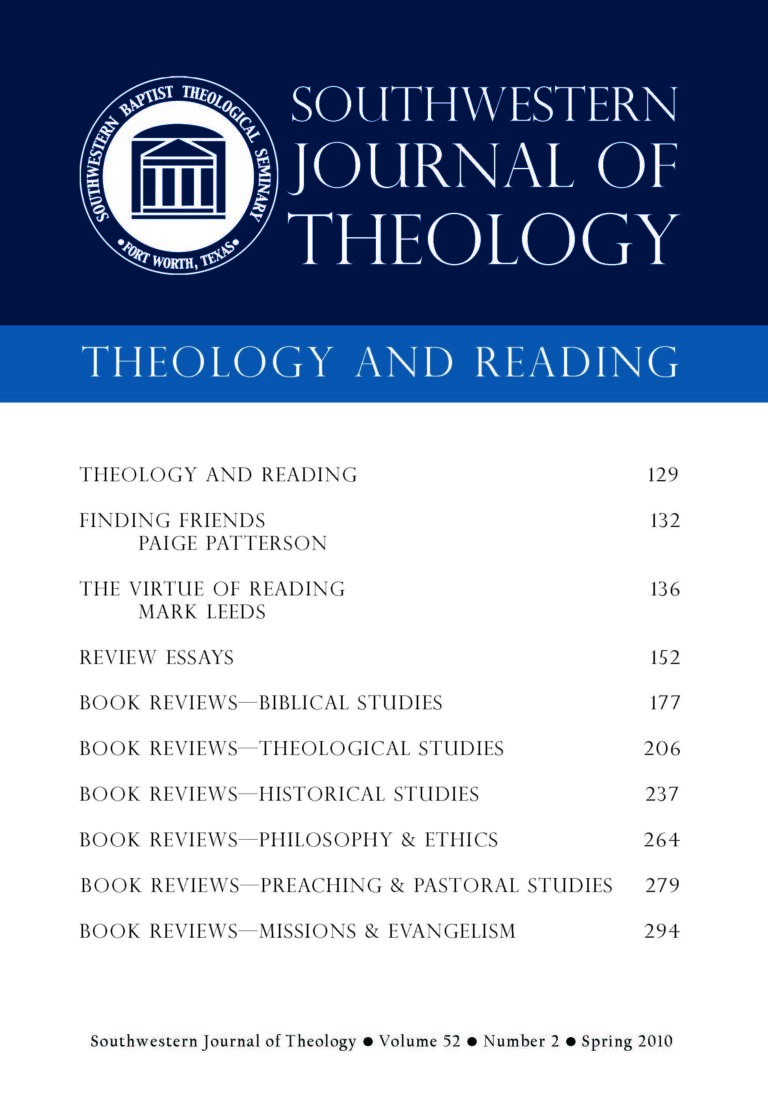
Theology and Reading
Southwestern Journal of Theology
Volume 52, No. 2 – Spring 2010
Managing Editor: Malcolm B. Yarnell III
By Thomas R. Schreiner. Grand Rapids, Mich.: Baker Academic, 2008. 990 pages. Hardback, $44.99.
In what seems like a saturated market of New Testament theologies, Thomas Schreiner’s own contribution to the description of a New Testament theology is refreshing, and just simply, ground-breaking in its own right. Schreiner has taken the widely-known thematic approach (cf. Gerhard Hasel’s New Testament Theology: Basic Issues in the Current Debate [Grand Rapids: Eerdmans, 1978], 73–132) with this primary thesis as the center: “that New Testament theology is God-focused, Christ-centered, and Spirit-saturated, but the work of the Father, Son, and Spirit must be understood along a salvation-historical timeline; that is, God’s promises are already fulfilled but not yet consummated in Christ Jesus” (23). Working out of this unifying center, the canonical books of the New Testament are then each examined according to the overarching thematic elements that hinge on the centrality of God.
The work is divided into four parts, which all have some dealings with “promise”: 1) “The Fulfillment of God’s Saving Promise,” 2) “The God of the Promise,” 3) “Experiencing the Promise,” and 4) “The People of the Promise and the Future of the Promise.” Only at an initial glance do these section titles seem slightly nuanced, but any serious reader would find himself richly immersed in a well-controlled discussion moving between narratives and doctrinal discussions, as well as scholarly contributions and contemporary debates that continue to this day.
The first section deals with the kingdom of God promised in the Old Testament and through the New Testament gospel narratives. Echoes of the “day of the Lord” and judgment from the Old Testament lead up to the opening scene in New Testament. Schreiner’s lively writing style and vivid imagery keep the readers engaged with what becomes ultimately the fulfillment of God’s promise of salvation through Christ unto the inaugurated eschaton, which the church experiences and awaits for its final consummation.
The second section is the largest of all the sections, and it consists of the bulk of Schreiner’s endeavor in the theological description of God. This is done through the Trinitarian framework as set up in the original thesis stated at the beginning. The centrality of God in the New Testament is worked through the synoptic gospels, the gospel of John, Acts, Pauline literature, James, Petrine and Johannine letters, Jude, and Revelation. How is God the center? Repeatedly is this question asked, to which Schreiner answers in multifaceted fashion: sovereignty, glory, father, Christ, name, love, wisdom, and revelation, amongst many others. Both Christology and pneumatology are part of the theological discourse concerning New Testament books. One may initially be underwhelmed by a cursory reading of the work, especially at the sight of the apparent repetition and overlap of material (e.g. “Jesus as Lord,” “Lordship and Divinity,” and “Centrality of Christ.”), but the command of Schreiner’s erudition subtly emerges in his handling of numerous scholarly discussions. Schreiner is not easily dismissive of novel, even new-fangled ideas and proposals, but he is very much willing to weigh the various sides of the dialogue, and arrive at a well-reasoned position, if at all possible.
Part of Schreiner’s novel approach is his engaging of extrabiblical sources for the purpose of providing some connections to contemporary writings. For instance, in one discussion of the Messiah and “Son of Man,” Schreiner briefly discusses the Gospels’ themes with second temple, postbiblical Judaic literature: Psalms of Solomon, Josephus, Dead Sea Scrolls, Testaments of the Twelve Patriarchs, Testament of Judah, and 4 Ezra. Schreiner gives ample reasons to dismiss any strong link or parallels to the Gospel materials, but his awareness of outside material demonstrates his erudition.
The third section focuses on the experience of the church through a Godcentered understanding of the New Testament, especially regarding the problems of sin and suffering, the question of faith and obedience (kinds of faith, whose faith), and salvation. The fourth and final section deals with the communal aspects of the church, and some discourse on the socio-scientific dimensions of the early church. These last two sections of the book do not really compare in size from the rest of the book because they deal with matters that stir the curiosity in the practical realm. Questions often arise as to the aftermath of the coming of Christ and the experience that results from various paradigmatic shifts in worldview.
Though the thematic elements may seem familiar, Schreiner’s work unapologetically treads on new grounds with his framing of God-centeredness, along with an engagement of the New Testament books, and academic discussions that have emerged in the past century. This contribution to the field of New Testament theology will be read and appreciated for many years to come.





